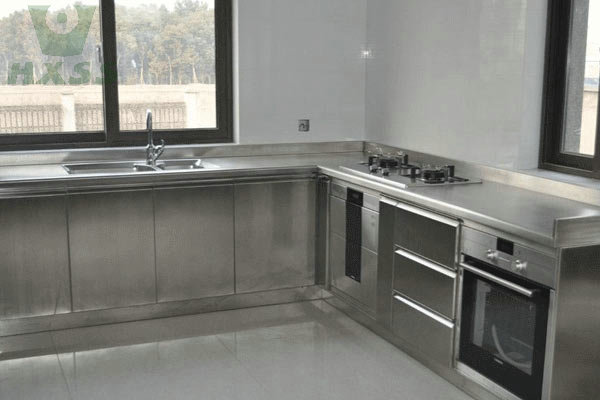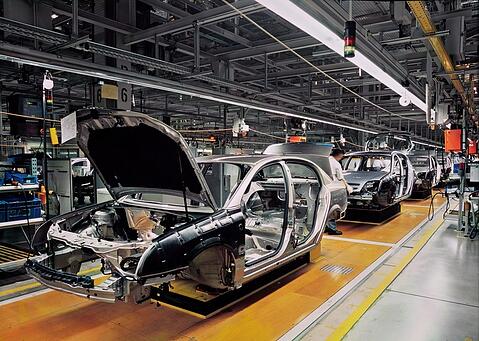Stainless steel is a widely used metallic material when we talk about materials used in fabrication and construction. The unique properties of stainless steel make it commonly used in industries such as construction, automotive, chemical, manufacturing, and medical equipment. There are many types and grades of stainless steel, two of the common types are 304 vs 409 stainless steel.
While both types of stainless steel are highly corrosion-resistant and robust, they differ in their chemical composition, physical properties, and application areas. This article will discuss the differences, advantages and disadvantages, and application scenarios of 304 vs 409 stainless steel to help readers better understand these two stainless steel materials so that they can choose the appropriate material according to specific needs.
304 VS 409 Stainless Steel: Chemical Composition and Physical Properties
304 stainless steel is one of the most common types of stainless steel and is widely used in the manufacturing and construction industries due to its excellent corrosion resistance, heat resistance, and ease of processing.
Chemical Composition
| Grades | C | Si | Mn | Cr | Ni | S | P | N |
|---|---|---|---|---|---|---|---|---|
| 304 | ≤0.08 | ≤0.75 | ≤2.0 | 18.0~20.0 | 8.0~10.5 | ≤0.03 | ≤0.045 | ≤0.1 |
| 409 | ≤0.08 | ≤1.0 | ≤1.0 | 10.5~11.7 | 0.5 Max | ≤0.03 | ≤0.045 | – |
409 stainless steel is a low-alloy steel that contains less chromium than 304 stainless steel.
Physical Properties
The physical properties of 304 stainless steel include a density of 7.93g/cm³, a melting point of 1400-1450°C, a thermal expansion coefficient of 17.2μm/m·°C, a thermal conductivity of 16.2 W/m·K, and a resistivity of 72 μΩ·cm.
The physical properties of 409 stainless steel include a density of 7.73g/cm³, a melting point of 1405°C, a thermal expansion coefficient of 11.2μm/m·°C, a thermal conductivity of 26 W/m·K, and a resistivity of 63 μΩ·cm.
304 and 409 Stainless Steel: Advantages and Disadvantages
Advantages and disadvantages: 304 stainless steel has good corrosion resistance and heat resistance, and is easy to process and form. Due to its high nickel content, it has high strength and durability. In addition, 304 stainless steel has good oxidation resistance and corrosion resistance and performs well for general corrosive media, such as atmosphere, freshwater, seawater, alkali, etc. The disadvantage is that in the strong oxidizing acid medium containing chloride ions, 304 stainless steel is prone to pitting corrosion and intergranular corrosion. At this time, it is recommended to choose materials with better corrosion resistance.
Advantages and disadvantages: The main advantage of 409 stainless steel is that it has good heat resistance and corrosion resistance, and it has good corrosion resistance to heat and chemical reaction media. In addition, 409 stainless steel has higher strength and ductility, so it is more durable in application. The disadvantage is that its corrosion resistance is slightly inferior to that of 304 stainless steel, so its application in strongly corrosive media such as strong acid, strong alkali, and chloride will be limited.
304 VS 409 Stainless Steel: Main Application Fields
Main application fields: 304 stainless steel is suitable for a wide range of application fields, including food processing, chemical equipment, pharmaceutical equipment, medical equipment, automobiles, architectural decoration, and other fields. It is widely used in the food industry and medical equipment due to its ease of cleaning and maintenance. In the field of construction and decoration, 304 stainless steel is widely used in interior decoration, railings, door handles, kitchen utensils, sinks, etc.

Main application fields: 409 stainless steel is widely used in automobile, manufacturing, and construction fields. Due to its good high-temperature resistance, 409 stainless steel is widely used in automobile exhaust systems. In addition, due to its high strength and good processing performance, 409 stainless steel is also used in various parts and structures in manufacturing and construction, such as chimneys, radiators, stoves, ovens, etc.

304 VS 409 Stainless Steel: Comparative Analysis
304 stainless steel and 409 stainless steel are two common stainless steel materials. They are different in chemical composition, physical properties, advantages and disadvantages, and application fields. The following will compare and analyze them:
Chemical composition The main composition of 304 stainless steel is 18% to 20% chromium, 8% to 10.5% nickel, a small amount of carbon, manganese, and silicon, and other elements. The main components of 409 stainless steel are 10.5% to 11.75% chromium, a small amount of titanium, copper and aluminum, and other elements. Compared with 304 stainless steel, 409 stainless steel has a lower nickel content.
Physical properties 304 stainless steel has a density of 7.93g/cm³, a melting point of 1400°C, a linear expansion coefficient of 17.2μm/m·°C, a thermal conductivity of 16.2 W/m·K, and a resistivity of 72 μΩ·cm. The density of 409 stainless steel is 7.73g/cm³, the melting point is 1405℃, the linear expansion coefficient is 11.2μm/m·℃, the thermal conductivity is 26 W/m·K, and the resistivity is 63 μΩ·cm. It can be seen that the density and thermal conductivity of the two stainless sheets of steel are different.
Advantages and disadvantages The advantages of 304 stainless steel are good corrosion resistance, toughness, and high-temperature resistance, and easy processing and cleaning. However, its cost is high, its strength is relatively low, and problems such as oxidation and embrittlement may occur at high temperatures. The advantage of 409 stainless steel is that it has good high-temperature resistance and strength, and is suitable for the medium of heat and chemical reactions. The disadvantage is that the corrosion resistance is relatively low, and corrosion may occur in media such as strong acids, strong alkalis, and chloride.
Application fields 304 stainless steel is widely used in food, pharmaceutical, chemical, and construction fields. 409 stainless steel is mainly used in automotive, manufacturing, and construction fields, especially in automotive exhaust systems.
In short, 304 stainless steel and 409 stainless steel have their own advantages and disadvantages, and the appropriate material should be selected according to specific application requirements. If you need stainless steel with stronger corrosion resistance, it is recommended to choose 304 stainless steel; if you need stainless steel with higher temperature resistance and strength, 409 stainless steel may be more suitable
304 and 409 Stainless Steel: Application Advice
Based on the above comparative analysis, we can draw the following application suggestions:
1. For occasions that require good corrosion resistance, such as food, pharmaceutical, and chemical fields, it is recommended to choose 304 stainless steel.
2. For occasions that require good high-temperature resistance and strength, such as automotive, manufacturing, and construction fields, it is recommended to choose 409 stainless steel.
3. If you need a material with good corrosion resistance and good high-temperature resistance at the same time, you can consider choosing 316 stainless steel. 316 stainless steel contains 2% to 3% molybdenum. Compared with 304 and 409 stainless steel, its performance in corrosion, wear resistance, and high temperature is better.
4. For occasions that require higher strength, it is recommended to choose other high-strength stainless steel, such as –174PH stainless steel, 15-5PH stainless steel, etc.
5. When choosing stainless steel materials, factors such as economy, processability, environmental impact, and reliability should also be considered.
In short, in practical applications, we need to choose appropriate stainless steel materials according to different needs and situations, so as to ensure that the performance and cost of the selected materials meet our needs to the greatest extent.
Chemical composition The main composition of 304 stainless steel is 18% to 20% chromium, 8% to 10.5% nickel, a small amount of carbon, manganese, and silicon, and other elements. The main components of 409 stainless steel are 10.5% to 11.75% chromium, a small amount of titanium, copper and aluminum, and other elements. Compared with 304 stainless steel, 409 stainless steel has a lower nickel content.
Physical properties 304 stainless steel has a density of 7.93g/cm³, a melting point of 1400°C, a linear expansion coefficient of 17.2μm/m·°C, a thermal conductivity of 16.2 W/m·K, and a resistivity of 72 μΩ·cm. The density of 409 stainless steel is 7.73g/cm³, the melting point is 1405℃, the linear expansion coefficient is 11.2μm/m·℃, the thermal conductivity is 26 W/m·K, and the resistivity is 63 μΩ·cm. It can be seen that the density and thermal conductivity of the two stainless sheets of steel are different.
Advantages and disadvantages The advantages of 304 stainless steel are good corrosion resistance, toughness, and high-temperature resistance, and easy processing and cleaning. However, its cost is high, its strength is relatively low, and problems such as oxidation and embrittlement may occur at high temperatures. The advantage of 409 stainless steel is that it has good high-temperature resistance and strength, and is suitable for the medium of heat and chemical reactions. The disadvantage is that the corrosion resistance is relatively low, and corrosion may occur in media such as strong acids, strong alkalis, and chloride.
In Conclusion
Based on the above analysis, we can draw the following conclusions:
- 304 vs 409 stainless steel are commonly used stainless steel materials, they have different advantages and applications in different fields.
- 304 stainless steel has good corrosion resistance and machinability and is suitable for food, pharmaceutical, and chemical fields.
- 409 stainless steel has good high-temperature resistance and strength, suitable for automotive, manufacturing, and construction fields.
- Different types of stainless steel materials have differences in performance. To choose a suitable stainless steel material, you need to consider many factors, such as economy, processability, environmental impact, and reliability.
- In practical applications, appropriate stainless steel materials should be selected according to different needs and situations, so as to ensure that the performance and cost of the selected materials meet our needs to the greatest extent.
Therefore, when choosing stainless steel materials, it is necessary to choose according to the specific application scenarios and needs in order to achieve the optimal effect.
